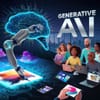Generative AI has become a powerhouse for producing text, images, audio, and video at scale, turning simple prompts into polished, human‑like output. Large language models such as GPT‑4, Claude 3, and Mistral excel at drafting blog posts, emails, product descriptions, and even legal documents, while diffusion models like Stable Diffusion and DALL‑E 3 generate photorealistic visuals from textual descriptions. This rapid content generation lets marketers create thousands of product listings in hours, designers produce mock‑ups without extensive manual work, and writers overcome creative blocks with AI‑suggested drafts.
Beyond static media, generative AI is pushing into video and audio realms. Tools like Runway ML, Pika Labs, and Synthesia turn scripts or images into short video clips, enabling companies to produce explainer videos, training modules, or internal announcements without hiring a full production crew. On the audio side, platforms such as ElevenLabs and MusicLM synthesize natural‑sounding speech and original music, allowing brands to craft consistent voiceovers, personalized greetings, and even multilingual dubbing with minimal cost.
The technology also fuels automation and personalization across business workflows. By integrating retrieval‑augmented generation (RAG) and fine‑tuning, enterprises can build AI agents that answer customer queries, summarize meetings, generate compliance reports, and suggest design variations based on user preferences. For example, banks use LLMs to auto‑generate regulatory filings, while e‑commerce sites deploy AI to tailor product recommendations and marketing copy for each visitor, boosting engagement and conversion rates.
Looking ahead, generative AI is set to reshape how work is done, making creativity and efficiency accessible to teams of any size. As models become more multimodal—handling text, images, audio, and video together—organizations can expect faster product development, richer customer experiences, and new revenue streams. However, success hinges on managing risks like hallucination, bias, and data security, ensuring human oversight remains integral to the creative process.


